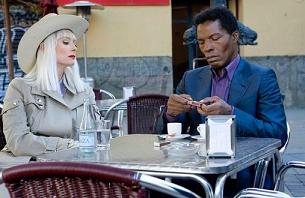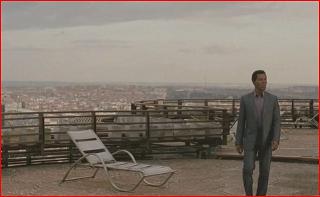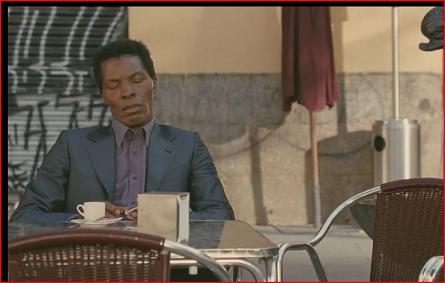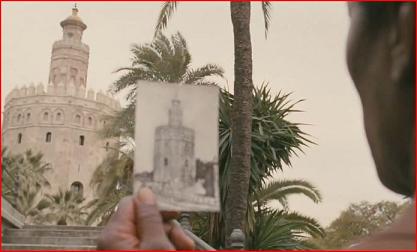January 7, 2010
The Limits Of Control: The Movie

Hmm. Matches. Wow.
People will describe The Limits of Control in different ways, but inevitably using the phrase "worse than getting raped in the penis." That's typed correctly. I did manage to find three reviews that did not include that phrase:
Here's the IMDb synopsis:
Don't ask me why, but this made me excited to think it would be a David Mamet redo of GI Joe: The Rise of Cobra. I was very mistaken. And I got retinoblastoma.
The main character is an iceman, highly focused on the job he was hired to do (which we don't understand.) He almost never displays emotion; he rarely talks. His face is made of concrete. Weird characters talk to him in cryptic sentences, pass him ciphers hidden in matchboxes which he reads, then eats. When he finds a naked billion (on a scale from one to ten, she's a billion) on his bed asking to have sex with him, he says, "never when I'm working." Control. He is frequently shown doing tai-chi, or staring at specific paintings in a museum: for focus. He always wears a suit when he is "working," day, night,sleeping, city, or in a desert.
That may sound like an excellent setup for a movie, except that there isn't any movie to go with it. None. Nothing happens in this movie, ever.
Here's a pivotal scene from the movie:

Now, it may be difficult to see from this photo what is actually happening, so I'll tell you: nothing. At all. I don't mean "nothing" as in "something, but it's boring," I mean nothing. For the whole scene. Let me emphasize again that this is a pivotal scene.
Here's a pivotal video clip:

You may raise an eyebrow: "hey, what are you trying to pull here, that's not a video clip, it's a still photo." Exactly. The Limits of Control isn't a movie, it's a series of photographs, each displayed for, oh, I don't know, 25 minutes each? and set to music. Bring blotter acid.
The movie seems to be offering you clues and hints about what's happening. I paused the movie on one of the ciphers to see if I could crack it, but I couldn't. I googled some of the phrases and images-- nothing. I wanted to figure it out, but couldn't.
The entire movie is populated with surreal images which beg for explanation, or at least a link to the haiku that passes for a script. No.

I have no idea what that building is, why he's looking at it, why he has a picture of it, and why it appears later on as a small statuette.
But, look, I don't own a North Face jacket, it's possible I'm just not hip enough to understand the symbolism. That turns out to be wishful thinking.
Example: Destro asks the waiter to bring him "two espressos-- in two separate cups." Hmm, intriguing. He's very emphatic about it, says it twice. But the waiter, who has to be deaf or retarded, instead brings him a double espresso. Destro yells at him, sends him back-- it's one of the only instances of emotion in the whole film. Hell, it's the only instance of action in the entire movie.
He does this, the ordering of two espressos, several times in the movie. This is framed and shot in such a way as to make its importance indisputable. So you say, ok, what gives? What is the relevance of two separate espressos? Is it a code, a signal? Is it an allusion to an Antonioni film, to Heidegger, what?
Turns out you are wasting your time: this isn't a symbol or clue, it was something that the actor actually did in real life, that the director, who was with him at the time, found funny. So he put it in the movie. "I found it amusing that he blew up at the guy." That's it. 'Art imitates life.'
Another example: the ending does have a sort of climax, but it's not obvious, so if you made it this far in the film you are paying close attention to everything, looking for some sort of explanation like it's the season finale of Lost. Why is does he change into that shirt? Why is he in an airport? Why is it green? etc.
In the last scene, the movie picture appears to jolt suddenly; the only way I can describe it is that it's as if the camera operator started putting the camera down before he turning it off. What's the significance of that jolt? It's in such contrast to the stillness of the rest of the movie. Does it mean it's all a dream? He's killed? What? No, believe it or not, that jolt happens because the camera operator actually did put the camera down before he turned it off. And the director liked the effect.
I had to watch 27 Dresses with Katherine Heigl to detox from this atrocity, but then I ended up getting the bends. But that was the end of my involvement with this movie.
Well, it was until this happened.
"It's an art movie with almost no dialogue, action, or story, about characters with no names who are doing either nothing or something that you never get to understand. And it's long."
"Take an action movie, remove all of the action scenes and dialogue, and send straight to video."
"Biggest waste of time I have experienced since the Obama state of the union address."
Here's the IMDb synopsis:
The Limits of Control is the story of a mysterious loner, a stranger, whose activities remain meticulously outside the law. He is in the process of completing a job, yet he trusts no one, and his objectives are not initially divulged. His journey, paradoxically both intently focused and dreamlike, takes him not only across Spain but also through his own consciousness.
Don't ask me why, but this made me excited to think it would be a David Mamet redo of GI Joe: The Rise of Cobra. I was very mistaken. And I got retinoblastoma.
The main character is an iceman, highly focused on the job he was hired to do (which we don't understand.) He almost never displays emotion; he rarely talks. His face is made of concrete. Weird characters talk to him in cryptic sentences, pass him ciphers hidden in matchboxes which he reads, then eats. When he finds a naked billion (on a scale from one to ten, she's a billion) on his bed asking to have sex with him, he says, "never when I'm working." Control. He is frequently shown doing tai-chi, or staring at specific paintings in a museum: for focus. He always wears a suit when he is "working," day, night,sleeping, city, or in a desert.
That may sound like an excellent setup for a movie, except that there isn't any movie to go with it. None. Nothing happens in this movie, ever.
Here's a pivotal scene from the movie:

Now, it may be difficult to see from this photo what is actually happening, so I'll tell you: nothing. At all. I don't mean "nothing" as in "something, but it's boring," I mean nothing. For the whole scene. Let me emphasize again that this is a pivotal scene.
Here's a pivotal video clip:

You may raise an eyebrow: "hey, what are you trying to pull here, that's not a video clip, it's a still photo." Exactly. The Limits of Control isn't a movie, it's a series of photographs, each displayed for, oh, I don't know, 25 minutes each? and set to music. Bring blotter acid.
The movie seems to be offering you clues and hints about what's happening. I paused the movie on one of the ciphers to see if I could crack it, but I couldn't. I googled some of the phrases and images-- nothing. I wanted to figure it out, but couldn't.
The entire movie is populated with surreal images which beg for explanation, or at least a link to the haiku that passes for a script. No.

I have no idea what that building is, why he's looking at it, why he has a picture of it, and why it appears later on as a small statuette.
But, look, I don't own a North Face jacket, it's possible I'm just not hip enough to understand the symbolism. That turns out to be wishful thinking.
Example: Destro asks the waiter to bring him "two espressos-- in two separate cups." Hmm, intriguing. He's very emphatic about it, says it twice. But the waiter, who has to be deaf or retarded, instead brings him a double espresso. Destro yells at him, sends him back-- it's one of the only instances of emotion in the whole film. Hell, it's the only instance of action in the entire movie.
He does this, the ordering of two espressos, several times in the movie. This is framed and shot in such a way as to make its importance indisputable. So you say, ok, what gives? What is the relevance of two separate espressos? Is it a code, a signal? Is it an allusion to an Antonioni film, to Heidegger, what?
Turns out you are wasting your time: this isn't a symbol or clue, it was something that the actor actually did in real life, that the director, who was with him at the time, found funny. So he put it in the movie. "I found it amusing that he blew up at the guy." That's it. 'Art imitates life.'
Another example: the ending does have a sort of climax, but it's not obvious, so if you made it this far in the film you are paying close attention to everything, looking for some sort of explanation like it's the season finale of Lost. Why is does he change into that shirt? Why is he in an airport? Why is it green? etc.
In the last scene, the movie picture appears to jolt suddenly; the only way I can describe it is that it's as if the camera operator started putting the camera down before he turning it off. What's the significance of that jolt? It's in such contrast to the stillness of the rest of the movie. Does it mean it's all a dream? He's killed? What? No, believe it or not, that jolt happens because the camera operator actually did put the camera down before he turned it off. And the director liked the effect.
I had to watch 27 Dresses with Katherine Heigl to detox from this atrocity, but then I ended up getting the bends. But that was the end of my involvement with this movie.
Well, it was until this happened.
28 Comments